Hyperhidrosis Treatment Melbourne: Locate the Right Clinic for You
Hyperhidrosis Treatment Melbourne: Locate the Right Clinic for You
Blog Article
Effective Too Much Sweating Treatments for Lasting Alleviation and Confidence
Extreme sweating, or hyperhidrosis, offers an unique challenge that can influence both personal and professional elements of life. While topical treatments like aluminum chloride antiperspirants frequently offer as an initial technique, more advanced treatments such as Botox and iontophoresis are getting attention for their efficacy in giving lasting alleviation.
Comprehending Too Much Sweating
Excessive sweating, clinically called hyperhidrosis, can significantly influence an individual's high quality of life, commonly causing physical pain and psychological distress. This condition is identified by unusually increased perspiration that takes place without regular triggers such as warm or workout. Hyperhidrosis can influence various body locations, including the palms, feet, underarms, and face, causing challenges in everyday tasks and social communications.
The underlying reasons of hyperhidrosis can be classified into 2 categories: main and additional. Key hyperhidrosis generally develops without any kind of identifiable medical condition and commonly has a hereditary part. On the other hand, secondary hyperhidrosis may arise from a hidden clinical concern, such as hormone problems, infections, or certain medicines.
Acknowledging the mental influence of excessive sweating is critical. Efficient treatment choices can help relieve both the physical symptoms and the emotional toll associated with hyperhidrosis, inevitably enhancing the overall quality of life for those affected.
Topical Treatments and Antiperspirants
Topical therapies and antiperspirants stand for the first line of protection for individuals handling hyperhidrosis. These products are designed to reduce extreme sweating with different energetic ingredients, with aluminum chloride being just one of the most reliable. This substance functions by obstructing sweat ducts, consequently lessening sweat in targeted locations.
Non-prescription antiperspirants usually have light weight aluminum salts and are appropriate for moderate to moderate cases of sweating. For more serious hyperhidrosis, prescription-strength solutions are offered, supplying higher concentrations of active ingredients for enhanced efficiency. It is vital to apply these products to completely dry skin, preferably at evening, to take full advantage of absorption and effectiveness.
Along with traditional antiperspirants, topical treatments such as glycopyrrolate creams can offer alleviation by hindering sweat gland activity. Customers may experience varying levels of success, necessitating a tailored method for individual demands.
While topical treatments and antiperspirants can substantially ease signs and symptoms, outcomes may vary (hyper sweating treatment). It is suggested for individuals to get in touch with health care experts to figure out the most appropriate item and application method, ensuring optimal end results for managing extreme sweating other properly
Medical Procedures for Relief
When topical treatments and antiperspirants do not provide enough alleviation for hyperhidrosis, people may look for a lot more sophisticated options via clinical procedures. Among the most effective alternatives is Botox (botulinum toxic substance), which briefly blocks the nerves accountable for sweating. This therapy is particularly beneficial for local areas, such as the underarms, hands, and feet, with results lasting a number of months.

For those looking for longer-lasting options, microwave treatment is an innovative strategy that destroys gland through targeted microwave power, commonly leading to long-term decrease of sweating in treated areas.
In a lot more serious situations, medical options such as sympathectomy might be considered. This intrusive treatment includes cutting nerves that trigger sweating, providing substantial relief yet also lugging possible dangers and adverse effects.
Way Of Life Changes and Home Solutions
Handling hyperhidrosis typically extends beyond medical therapies, as way of living adjustments and natural remedy can substantially ease signs and symptoms. Initially, putting on breathable fabrics such as cotton or moisture-wicking materials can aid control body temperature and decrease sweat. Baggy clothes is additionally recommended, as it enables for better air flow.

Preserving proper hygiene is essential. Frequently showering and using antibacterial soap can help control odor and maintain skin dry. Natural home remedy like applying corn starch or baby powder to issue locations can take in wetness and improve convenience throughout the day.
Lastly, think additional info about using all-natural antiperspirants including components like aluminum chloride or witch hazel, which can offer reliable relief without extreme chemicals. By carrying out these way of living modifications and natural home remedy, people might locate significant alleviation from hyperhidrosis, fostering higher self-confidence in day-to-day activities.
Looking For Expert Assistance

One usual approach is prescription antiperspirants, which have greater focus of aluminum chloride, effectively obstructing gland. For much more severe situations, treatments like iontophoresis, Botox shots, or prescription drugs may be employed. Iontophoresis utilizes electric currents to momentarily disrupt the function of sweat glands, while Botox functions by preventing the nerves that set off sweating.
In particular situations, surgical alternatives, such as sympathectomy, might be thought about. This invasive procedure includes reducing nerves liable for sweating, providing a much more irreversible solution.
Additionally, specialists can offer advice on managing the emotional influence of hyperhidrosis, consisting of references to therapy or support system. Generally, consulting a health care service provider guarantees a comprehensive therapy plan tailored to specific needs, eventually boosting lifestyle and self-confidence for those affected by extreme sweating.
Conclusion
In conclusion, effective monitoring of excessive sweating involves a multifaceted strategy that encompasses topical treatments, advanced clinical procedures, and lifestyle modifications. An extensive technique not only reduces the physical signs of hyperhidrosis yet likewise promotes enhanced confidence and overall quality of life for damaged people.
Report this page